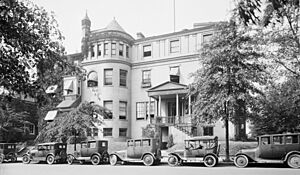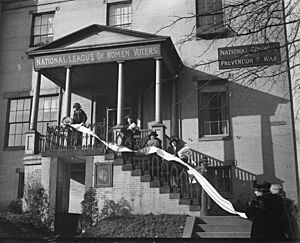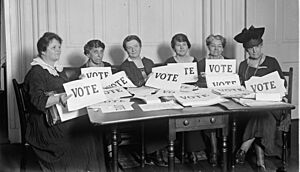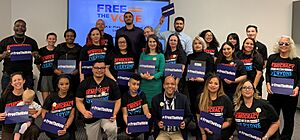League of Women Voters facts for kids
 |
|
| Founded | February 14, 1920 |
|---|---|
| Type | Nonprofit |
| Focus | Political education and advocacy |
| Location | |
|
President
|
Dianna Wynn |
The League of Women Voters (LWV) is an American group that helps people understand politics. It is a nonpartisan organization, meaning it does not support any specific political party or candidate. The LWV was started in 1920. Its main goals are to help people register to vote, give them information about elections, encourage more people to vote, and protect voting rights.
The League of Women Voters also works with other groups on important issues. These include making rules for how political campaigns are paid for, supporting women's rights, improving health care, and working on gun control. The League was formed after the National American Woman Suffrage Association finished its work. That group had fought for women to get the right to vote.
The League's first goals were to teach women about politics and to support laws that helped women. Because it is nonpartisan, a big part of its job is to help people register and learn about voting. But it also speaks up for issues that its members care about. These issues are chosen at meetings held every two years. The League is known for carefully studying an issue before deciding what to support. Its rules do not allow it to support any specific candidates or political parties.
Contents
What the League Does
VOTE411.org Website
VOTE411.org is a helpful website run by the League of Women Voters. It is available in both English and Spanish. Voters can type in their address to find information about candidates and elections in their area. The site includes answers from candidates to three questions about their plans for office. The League of Women Voters, along with its state and local groups, manages this website. It even won an award in 2020 called a Webby Award.
National Voter Registration Day
In 2012, the League of Women Voters started National Voter Registration Day. This is a special day when volunteers work to help people register to vote. It also encourages more people to take part in elections.
Hosting Debates
Local and state League groups often host debates for candidates. These debates help voters learn about what candidates think on different issues. They cover elections at all levels of government.
History of the League
How the League Started
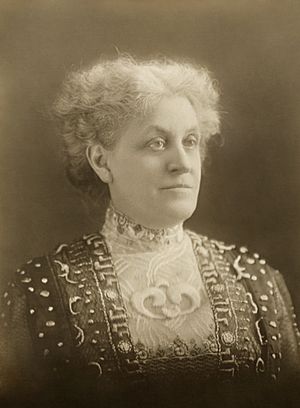
The League of Women Voters was created in 1920. It was formed by combining two groups: the National American Woman Suffrage Association (NAWSA) and the National Council of Women Voters (NCWV).
The main goals of the new League were to teach women about elections and to support laws that helped women. These were the same goals as the NCWV, which Emma Smith DeVoe had started in 1911. She began the NCWV after her idea for such a group was not accepted by NAWSA in 1909.
Ten years later, before the 1919 NAWSA meeting, Carrie Chapman Catt talked with Emma Smith DeVoe. Catt wanted to combine DeVoe's group with a new league that would take over from NAWSA. Catt wanted to create a political process that was fair and focused on issues, led by citizens, not just politicians. She worried that joining political parties would make the League less independent.
By 1919, fifteen states had already approved the Nineteenth Amendment to the United States Constitution. This amendment would give women the right to vote across the country. Women wanted to prepare for this by teaching others about voting and helping them take part.
At the 1919 NAWSA meeting, a plan was made to combine the two groups into the National League of Women Voters. The merger officially happened on January 6, 1920. For the first year, the League worked as a part of NAWSA. The League's official structure was set up at a meeting in Chicago in 1920.
Carrie Chapman Catt was named an honorary leader of the League. She believed that younger women should lead the new organization. Over time, the League has worked to be more welcoming to all women. Its goal now is to "protect and expand voting rights and ensure everyone is represented in our democracy."
The 1920s
In the 1920s, the League focused on a few main issues. These included extending the Sheppard-Towner Act, supporting a Child Labor Amendment to the Constitution, and teaching people about voting.
The Sheppard-Towner Act, first passed in 1921, gave money to states that offered education on caring for mothers and babies. It was extended twice but ended in 1929. It was later brought back as part of the Social Security Act in 1935.
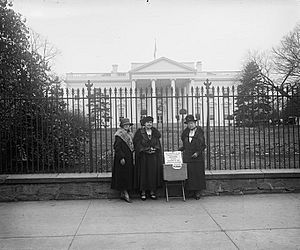
In 1923, a special committee of the League chose twelve women as the "greatest living American women." These included Jane Addams and Carrie Chapman Catt.
At the League's 1926 meeting, its president, Belle Sherwin, said that teaching people about politics was key to a true democracy. She talked about how schools could help students learn to read newspapers carefully and avoid being easily swayed by crowds.
In 1926, the New York League helped set up information booths in stores. They taught women how to register to vote and showed them how voting machines worked. They also explained literacy tests and registration times. The League also gave talks before elections.
In the 1930s, the League supported new government programs. These included Social Security and laws about food and drugs.
From 1940 to 1969
In 1945, the League supported the creation of the United Nations, the World Bank, and the International Monetary Fund. The UN recognized the League as a permanent observer, which meant it could attend most meetings.
In the 1950s, a League member named Dorothy Kenyon was wrongly accused of being a Communist. The League's president, Percy Maxim Lee, spoke to Congress against Senator Joseph McCarthy's unfair investigations.
In 1960, the League supported a law about natural resources. This was the start of its long history of working on environmental issues.
The League eventually supported the Civil Rights Act of 1964 and the Voting Rights Act of 1965. In 1968, the League began to oppose unfair housing practices. It also supported voting rights for people in Washington, DC.
In 1969, the League was one of the first groups in the U.S. to ask for normal relations with China.
From 1970 to 2000
In the 1970s, the League began to support the Equal Rights Amendment. This amendment aimed to ensure equal rights for all people, regardless of sex.
In 1974, the League started allowing men to become members.
The LWV helped organize the United States presidential debates in 1976, 1980, and 1984. But in 1988, the League decided to stop sponsoring the debates. They felt that the rules set by the major candidates would not allow for a fair discussion. The League's president, Nancy Neuman, said they would not help "hoodwink" the American public. After that, other groups took over the debates.
In 1998, the League elected its first African-American president, Carolyn Jefferson-Jenkins. She served until 2002 and wrote a book about the history of women of color in the League.
The League also worked hard for the 1982 changes to the Voting Rights Act. In the 1990s, it was important in passing the National Voter Registration Act of 1993. This law is also known as the Motor Voter Act. It requires states to offer voter registration at places like driver's license offices and social service agencies.
From 2000 to Today
In 2002, the League supported the Help America Vote Act. This law aimed to make voting easier and more secure. It also supported the Bipartisan Campaign Finance Reform Act. This law changed how political campaigns could be funded.
In 2014, the League helped create voter guides like Smart Voter and Voter's Edge. These guides helped people learn about candidates.
In 2018, the League took a strong stand against Brett Kavanaugh becoming a Supreme Court Justice. They were concerned about his past and how it might affect the fairness of the courts.
In 2020, the League of Women Voters supported Native Americans. They worked to remove rules that made it harder for Native Americans to deliver their ballots from reservations.
In 2021, the League of Women Voters of Florida worked with other groups. They helped tell voters about new changes to Florida's voting laws. They also filed lawsuits against these changes.
After the January 6 United States Capitol attack in 2021, the League's board spoke out strongly. They called for legal ways to remove the then-President. This and other positions, like supporting transgender rights, have led some people to criticize the League. Some states have made it harder to register voters. This has caused the League to stop registering voters in some places, like Kansas, to avoid legal problems for its members.
What the League Believes In
The League works to influence laws at the national, state, and local levels. Its beliefs on national issues are decided at its national meetings. State and local League groups decide their own beliefs on local issues. These must fit with the national positions.
The League was started by women who fought for the right to vote. So, it has always cared about voting and fair government. The League also works on issues like international relations, natural resources, and social policy.
Voting and Government
In 1993, the League pushed for the National Voter Registration Act of 1993. This law requires states to offer voter registration at places like driver's license offices.
The League works with the VoteRiders group to share information about voter ID rules in different states. In 2002, the League supported the Bipartisan Campaign Reform Act. This law limited how much money could be given to federal elections. It also strongly supported the Help America Vote Act.
In 2010, the League disagreed with a Supreme Court decision called Citizens United v. Federal Election Commission. This decision removed limits on how much money companies could give to candidates.
The League supports the DISCLOSE Act. This law would make campaign spending more public and faster to see. It would also help fight "dark money" in U.S. elections.
The League currently opposes strict photo ID laws for voting. It supports campaign finance reform in the United States. This includes public funding for elections and limits on how much candidates can spend. It also wants to get rid of groups called super-PACs.
International Relations
The League worked to create the United Nations. It later became one of the first groups to be recognized by the U.N. as a non-governmental organization. The League has always worked to promote world peace and international cooperation.
Natural Resources
The League supported important environmental laws. These include the Clean Air Act, the Clean Water Act, and the Safe Drinking Water Act. It also supported the Kyoto Protocol, an international agreement on climate change. The League opposes the proposed Keystone Pipeline project. In 2013, the League of Women Voters in Hawaii asked President Obama to take action on climate change.
Social Policy
The League opposes school vouchers. In 1999, the League of Women Voters of Florida challenged a state law that allowed students to use vouchers to attend other schools.
The League supports universal health care. This means they believe everyone should have access to health care. They support expanding Medicaid and the Affordable Care Act.
The League also supports ending the death penalty.
LGBT+ Rights
The League of Women Voters supports LGBT+ rights. They believe that protecting democracy and ending discrimination against the LGBTQ+ community go together. They have also supported transgender athletes taking part in girls' and women's sports.
How the League is Run
National Level
A national board of directors leads the League. This board includes four officers and eight elected directors. There can also be up to eight directors chosen by the board. Most of these leaders live near Washington, D.C. The national board is chosen at the national meeting and sets the League's main policies.
State and Local Groups
League of Women Voters of Alabama|League of Women Voters of California|League of Women Voters of Florida|Missouri League of Women Voters|League of Women Voters of Wisconsin Local and state League groups are set up to help the League's goals. They also work on government issues in their own areas. These groups have their own leaders. The national board can remove recognition from any state or local group if it does not meet the requirements.
The League of Women Voters has state and local groups in all 50 states, the District of Columbia, the Virgin Islands, and Hong Kong.
See also
 In Spanish: Liga de Mujeres Votantes para niños
In Spanish: Liga de Mujeres Votantes para niños
- List of notable members of the League of Women Voters
- List of women's clubs
- National Organization for Women


